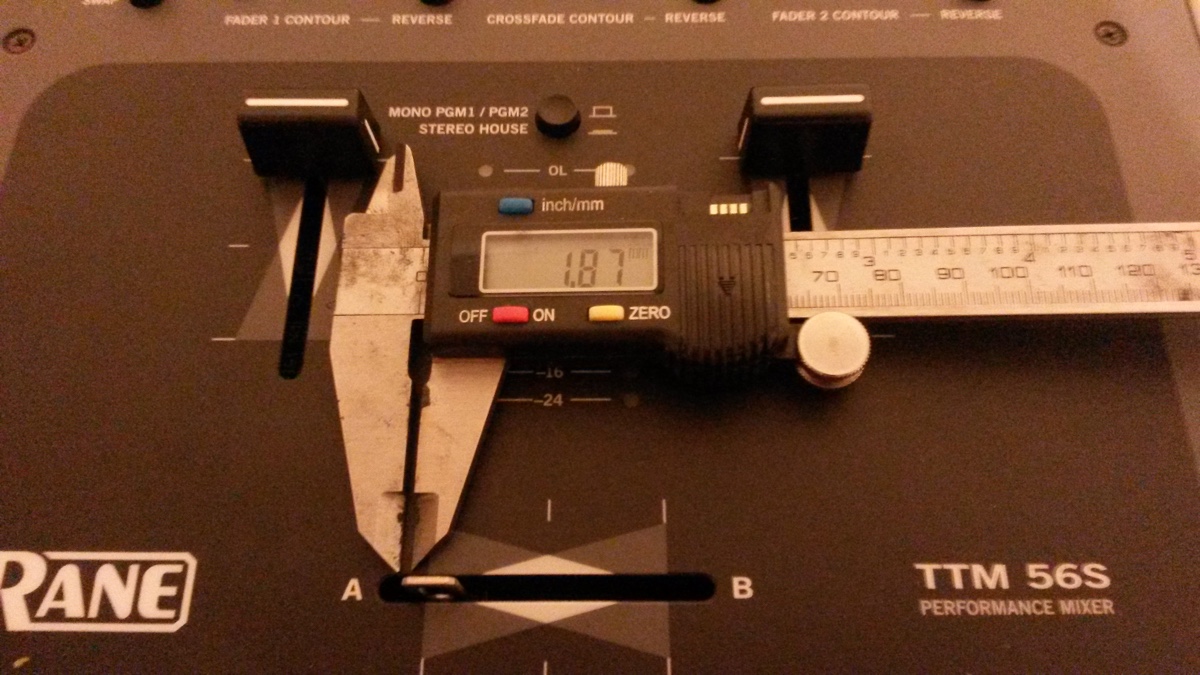Rane TTM56s cross fader dead zone
So the first thing I noticed when I hopped on the TTM56s to cut... there was a HUGE dead zone at the end of the fader. The 56 didn't have it... so what gives? I'd bought the mixer used off of Ebay, so understandably, I first blamed the previous owner. After doing some poking around and not seeing anything blatantly out of order, I took to the internet. Turns out, I'm not the only person! The solutions were jenky, and didn't work for me. For the expense of this mixer, and being a mixer from rane I was thoroughly unimpressed! I even swapped out the cross fader with a line fader (They're all interchangable) and the issue was identical. This was surely not a fluke issue, it was consistently the same accross all of the mixers.
So after a bunch of futzing about, I decided to fully document this as it should be noted.
The issue, Quantified:
When scratching, fader control is essential. A large dead zone at the end of the fader can result in a longer cut off during particular scratch moves, and some techniques that are very small such as crabbing may not even work. Now, the amount of dead zone may have some various desire for different users... which is where this all gets tricky. Let's dive into just how bad my issue was.
Most people had guestimate measurements. I went ahead and actually measure with a digital caliper. The dead zone was 1.87mm per side. Now... this may not exactly sound like very much space to you, but let's consider that the fader is only 45mm long. That means that approximately 8% of the fader is dead zone. Not exactly worthless now is it? Consider if the first 8% of your gas pedal did nothing. Now you're feeling me. Below is my measurement.It was taken by establishing the furthermost left point, and then moving the fader until sound came in and taking a measurement. I may be inaccurate to 1/100th of a mm, but this measurement is more than accurate to quanity this issue.
By comparison the original Rane 56 that I have, unmodified, has 0.3mm of cut in and the cut in is very much on/off.

So this issue is now clearly defined, and not all in my head and/or perhaps a mater of my perception. Given that I switched all of the line faders in and out and they all had the same issue lends me to believe this is a consistent issue.
To help further understand the problem, a user needs to understand how the crossfader actualy works, which is of course where the solution that is advised by most people is located.

In this image, you can clearly see the indicated sensors. There is a cylinder formed into in the middle of the actual fader body that contains a magnet. Those sensors on the end detect the magnet, and how much force the magnet exerts on the sensors determines the fader position. Simple enough right? So when the fader gets close enough to the sensors, it will cut a particular channel all the way off.
The problem as it would seem, is that the magnets are strong enough to trigger the sensors reading for "all the way over" before it is actually all the way over. There have been two solutions for this that I have seen:
Solution #1: Bend The Sensors
The first solution is to bend the sesnors. Bend them AWAY from the middle of the fader to reduce the dead zone. The problem with this that I encountered however, is that my sensors were all the way pushed up against the tabs surroundign the sensor.
My solution to work around this? Dissasemble the fader (very easy), and then take a razor blade to shave the plastic back to allow the sensor to bend more. Further bending of the blade allowed me to bend the sensor quite far... but this is all VERY jenky for an $800 mixer. I am thoroughly unimpressed.
Solution #2: Fill the dead space with a material
So a solution I quickly found on Youtube involved scavenging o-rings from a bic lighter and placing them onto the metal arms of the fader in place of the original ones. This solution works in the sense that it fills up that dead zone, so you hit the end of fader travel. This works... but reduces the fader length from 45mm. Considering that 8% of the fader never actually worked though, it's not exactly a loss.
I would personally not recocommend scavenging o-rings from a lighter. Considering any major hardware store will have a plethora of orings and washers in the various sizes, I'd recommend starting there. For the cost of one lighter you'll get MORE than enough materials, and you won't risk pouring butane all over the place.
My working solution:
The first solution just didn't work for me. I was only able to get the cut in down to just under 1mm, and that was still 3x more cut in than the original 56.
The second solution resulted in too much material, leaving the fader always on. This however, combined with bending the sensor in towards the middle allowed me to acheive the 0.3mm cut in time of the original 56.
Exact o-ring dimensions to come. I will be getting everything sized up at a hardware store near me soon!